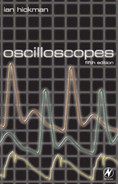
48 Oscilloscopes
it impossible to remove the latter when it is desired to use a
different graticule.
The purpose of the tinted sheet is to improve the contrast
between the trace and the rest of the screen. The brightness of the
trace is reduced somewhat by the tinted sheet, but the trace's
light only has to pass through the sheet once. Ambient light, on
the other hand, is attenuated as it passes through the sheet before
being reflected from the c.r.t, screen, and attenuated again as it
passes out, resulting in improved contrast. The improvement is
even greater for colours different from that of the trace.
Increasingly, a neutral grey-tinted sheet is used in place of one
the same colour as the trace. The material is a special plastic sheet
with the property of circularly polarizing light which passes
through it. The trace is little attenuated, because it is initially
unpolarized and only passes through the filter once, but ambient
Figure 4.10 The VC-7502 dual channel 100Ms/s digital storage oscilloscope
provides a 150 MHz bandwidth. GPIB and RS232 are standard, and IEEE-defined
pulse parameter measurements can be automatically measured. The VC-7504 is
similar but has four channels (reproduced by courtesy of Hitachi Denshi (UK) Ltd)

Accessories 49
light falling on the screen of the c.r.t, is circularly polarized. Upon
reflection, its circular polarization is now of the wrong hand to
pass back through the filter, resulting in much improved
contrast.
In particularly bright surroundings a mesh filter can be used.
This is a fine metal mesh finished in matt black; it reduces the
brightness of the trace by about a quarter, but provides very high
attenuation of ambient light reflections.
Special graticules have been developed for fitting to an
oscilloscope in place of the standard one. A typical example is a
graticule with nominal and limit markings for a sine-squared
pulse-and-bar test waveform, used for testing television equip-
ment response times and differential gain and phase. Smith chart
and polar graticules are also available, but these are generally
used with a special-purpose oscilloscope display forming part of a
network analyser.
Mains isolation
The Y input sockets on an oscilloscope normally have their outer
screens connected to the instrument's metalwork and thus to the
earth wire in the mains lead. Thus the input as it stands cannot be
connected to circuitry which is at a different potential from mains
Figure 4.I1 Showing typical scale-factor readouts on a modern high perform-
ance oscilloscope - the PM3094 featured in Chapter 3. (a) A typical measurement
application, with the Delta Time cursors in use. The measurement is displayed as
both period and frequency. (b) A (main) and B (delayed) timebases in use. The
highlighted portion of the A trace is displayed on the lower delayed trace, which
starts 180.0 p~s later than the main trace

50 Oscilloscopes
Figure 4.12 100 Base T signal testing with standard communications mask, on
a TDS instrument from the Tektronix range (courtesy Tektronix UK Ltd)
earth, for example live-side components in a direct-off-line
switchmode power supply. Hence the highly deprecated and very
dangerous practice of disconnecting an oscilloscope's earth lead.
However, under specific conditions, safety standards do permit
indirect grounding as an alternative to direct grounding. All of the
grounding requirements apply, except that the grounding circuit
need not be completed until the available voltage or current
exceeds a prescribed amount. The Tektronix A6901 Ground
Isolation Monitor fits between an oscilloscope and the mains, and
cr monitors the w~ltage on the instrument's case/
metalwork. The latter is permitted to float up to 40 V peak, 28 V
rms from ground. When this value is exceeded the mains supply to
the instrument is interrupted, the isolated grounding system is
connected to the supply grounding system, and an audible alarm is
sounded. Applications include connecting the oscilloscope ground
to the-2 V load-return reference rail instead of zero volts in ECL
circuits to reduce probe loading, and reducing hum problems in
low-level audio circuits by aw~iding earth lr
An alternative approach to mains isolation is to disconnect the
mains lead entirely. The Tektronix models 222A, 222PS and 224
can operate for typically four to six hours from internal sealed
lead/acid batteries, or suitable external d.c. or a.c. supplies. Of
double-insulated, impact-resistant, plastic construction, these
oscilloscopes when operated from their internal batteries can be

Accessories 51
floated at up to +850 V d.c. plus peak a.c. above or below ground
(+400 V in the case of the 222 A). Although discontinued, these
items appear from time to time on the second user market, very
modestly priced, and can therefore be worth acquiring where off-
earth measurements must be made.
Normal safety rules should always be observed when working
with high voltages, especially where the ground lead of the probe
is at other than earth potential. It is unwise to work on
equipment with voltages in excess of 50V if there is no other
person in the same area.
Yet another alternative is signal voltage isolation. This is
covered in the next chapter.
..................Content has been hidden....................
You can't read the all page of ebook, please click here login for view all page.
